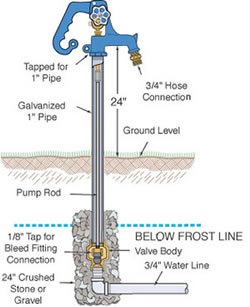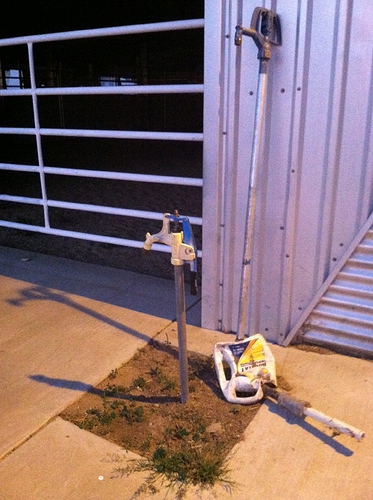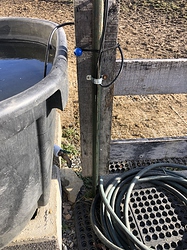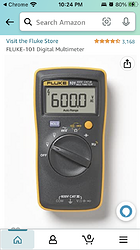I had never heard of the Drinking Post waterer. Now that I have visited their web site and read, I still do not understand what keeps the dirt from entering the water supply when the horse first starts to drink. They say it works on the same principal as a freezeless farm hydrant. But when I use my hydrants, the first blast of water that comes out after it has been turned off and drains is contaminated with dirt. Could someone with Drinking Post expertise please chime in and explain how they keepsthe water clean?
That shouldn’t happen. Something is wrong with your installation.

One day in the future (we’re talking like 10 year plan), I hope to install electricity-free waterers like the drinking post or bar bar a. But that’s pretty far down the priority list right now!
OK, I am confused about yard/farm hydrants. Mine are weep-hole hydrants, where the water drains out of the tube via a weep hole when the handle is in the closed position. As long as the handle is off, the weep hole stays open to the ground the hydrant pipe is buried in, and dirt can work its way into the weep hole during rains and such. The first blast of incoming water flushes the dirt out of the vertical tube.
I see there are also sanitary hydrants, that have a weep hole as well, but the weep hole is located inside a sealed drain chamber. So with a sanitary hydrant, there is a sealed system.
Currently I just turn on my hydrants, wait until the water changes from dirty to clear (takes only a second or two), and then fill water troughs.from them. So there is soil contamination potential.
Did I buy the wrong type of hydrants? This is my first farm and I’m learning the hard way sometimes.
I’m not the hydrant expert. There are people here who know far more than me.
I’m pretty sure 99% of people just use the weep hole variety.
But if it is installed correctly, deeply enough, with enough rock around it to facilitate drainage, it shouldn’t be wicking visible mud and dirt through the weep hole.
@LCDR Mine used to do that and it would freeze when it got really, really cold. I dug out around it and discovered that there was no gravel installed around the bottom, it was just dirt. That explains the dirty water and the freezing (the water couldn’t drain well through hard-packed dirt). I added gravel then covered the hole and both problems are now fixed.
the four hydrants I installed here are set over a bed of gravel to give the water being discharged a place to go, I extended the gravel up the pipe some. I never have seen any dirt being discharged with the water
Thanks. I will dig out around one easiest to get to and check for gravel. Should not be too much work as the bury depth here is one foot. The one I use the most comes up through the concrete slab barn aisle. Now that will be a challenge.
Now back to deicers. I have two plastic troughs the length of the barn apart under the barn overhang. Both are on wood stands, and the stands are on rubber mats. Horses have to stand on the mats to drink. I fill them with a hose. Just before the forecast freeze, I bought a 250W submerged trough heater at TSC to put in one tank. I plugged it into an outlet that is on a circuit with a ground fault breaker in the barn electrical panel. But now the horses will not use the heated tank, even when the other tank is frozen over. What to do?
For anyone that is installing a hydrant, try putting an empty plastic can of any kind in the bottom L, to keep sand and dirt off the weep hole, like this here, then pour gravel around it on the bottom.
We have done that for decades and have yet to find any trouble with them, some hydrants have been in the ground over 50 years and are still working fine:
It’s possible your horses are feeling some electric shock from the heater. If you have a multimeter you can check for stray current, you can also ground your tank to see if it helps. I grounded mine using just a t-post since I had minimal current and the post was conveniently there already.
I have a Fluke multimeter similar to this one:
@LCDR, what you are experiencing with some dirt with your hydrant is not really uncommon at all.
It is clearly not optimal, but it is something you can wait until the weather allows you to dig it up and make a good drainage bed down there.
I would guess that more people get some dirt than realize are getting some dirt.
I hear you. I wish I’d discovered COTH much earlier than I did. But better late than never, I’ve learned a lot on these boards and my horses (and me) are better for it.
For over 20 years, I have used the sinking deicers in a rubber trough. I find I have to replace them every 5 years or so.
I’ve never used the drain plug heaters but my friend who uses them keeps them in the troughs all year long. She loves them.
I once bought one of those K&H floating heaters without the auto-shutoff. Somehow it ended up half out of the water and caught on fire!! So if you go for any kind of heater that a horse could play with, make sure it has an auto-shutoff!!
Yikes!
For as far back as I can remember, we used this style floating heater and never had a problem.
But when I finally got my own farm, I ended up with these of a different brand. They have worked fine.
Only within the past 10 years did I start having problems with horses messing with them. Compounded with internet horror stories, I’m now weary of using the floating style.
So I switched to heated muck tubs and plug deicers. Maybe I shouldn’t ever remove the plug deicers, but it’s impossible to clean under them in the summer. Plus I worry about the cord out in the elements year round.
I know that others have already addressed this, but the water is clean, and there is no dirt coming up (I played with and have checked the Drinking Post quite a bit). It dispenses clean water every time. I think it’s just a matter of having them set up right.



